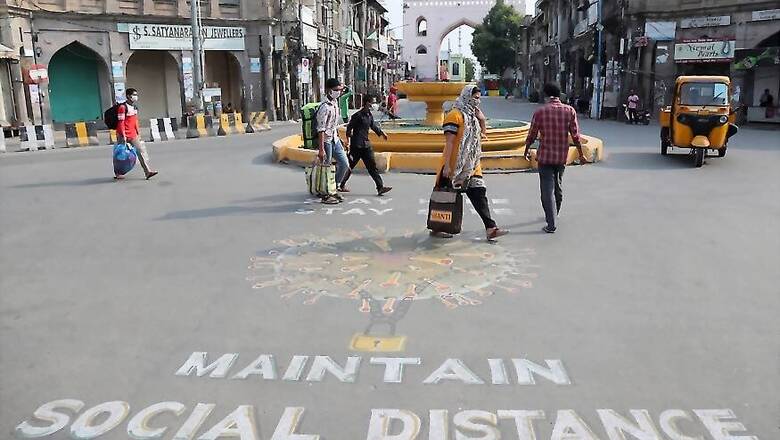
views
The nationwide tally of COVID-19 cases crossed 1.45 lakh on Tuesday with states like Bihar, West Bengal, Assam and Odisha reporting significant rise in their numbers amid large-scale return of migrant workers from other states. Odisha Chief Minister Naveen Patnaik warned of more challenging days ahead and called for a new strategy to check the pandemic.
The numbers also rose further in the worst-hit states including Maharashtra, Gujarat and Tamil Nadu, while Delhi, Punjab, Madhya Pradesh, Chhattisgarh, Kerala, Karnataka and Andhra Pradesh also reported new cases.
Some experts flagged there is a need for more intense surveillance and monitoring in areas where migrants have returned to contain the outbreak.
The Union Health Ministry, however, said the recovery rate in the country has seen an upward trend and is better than many other countries, while the fatality has fallen further.
At a press briefing, Health Ministry Joint Secretary Lav Agarwal said, "The recovery rate in the country continues to improve and is presently 41.61%. The COVID-19 fatality rate has reduced from 3.3% on April 15 to 2.87% which is among the lowest in the world."
In its morning update, the ministry said the COVID-19 death toll has risen to 4,167 and the number of cases has climbed to 1,45,380 in the country, registering an increase of 146 deaths and 6,535 cases since Monday 8 AM. It put the number of active cases at more than 80,000 and recoveries at over 60,000.
The ministry also suggested to the five states reporting a surge in COVID-19 cases over the last three weeks to analyse the trends in containment zones and adopt course correction measures through proper implementation of micro-plans. These states are Uttar Pradesh, Bihar, Jharkhand, Chhattisgarh and Madhya Pradesh.
Several states have been attributing the increase in their tallies to arrival of people from outside in special trains, being run since May 1 to ferry migrant workers to their native places, and special international flights that began on May 1 to bring back stranded Indians and expatriates from abroad. Besides, domestic flights have also begun since Monday in a phased manner.
During a review meeting on the COVID-19 situation in Odisha, which saw its tally rising to 1,517 with 79 new cases, Patnaik said a new strategy would be needed to deal with the pandemic.
"With flight and train services having been restored, the next 15 to 30 days will be challenging, but I am sure we will be able to handle it all in a professional manner," he said.
More than three lakh people have returned to the state in Shramik Special trains and buses in a span of just 24 days.
Overall, Indian Railways has ferried over 44 lakh migrant workers on board 3,276 'Shramik Special' trains since May 1, according to official data.
The maximum number of these trains have originated from Gujarat, Maharashtra, Punjab, Uttar Pradesh and Delhi, while the highest number of those have terminated in Uttar Pradesh, Bihar, Jharkhand, Odisha and Madhya Pradesh.
The Delhi government has sent around 2.41 lakh people back to their home states in 196 trains since May 7, Deputy Chief Minister Manish Sisodia said on Tuesday. Of these, nearly 1.25 lakh people were sent to Bihar, 96,610 to Uttar Pradesh, 3,000 to Jharkhand, 2,500 to West Bengal and 2,100 to Madhya Pradesh.
Many experts have warned that the return of migrant workers to their native places may create a huge labour shortage and further hit the economy, which is facing a deep recession due to the pandemic and restrictions related to the nationwide lockdown, in force since March 25.
Rating agency CRISIL predicted a GDP decline of 5 per cent for the current fiscal and a staggering 25 per cent contraction in the current quarter (April-June 2020).
"About 10 per cent of the gross domestic product (GDP) in real terms could be permanently lost. So going back to the growth rates seen before the pandemic is unlikely in the next three fiscals," it said.
Several relaxations have been given in the ongoing fourth phase of the lockdown, which began on May 18 and is scheduled to continue till May 31, to revive economic activities. While domestic flights have also resumed, a chaotic situation continued for the second day amid several cancellations.
Congress leader Rahul Gandhi said the four phases of the nationwide lockdown have "failed" and not given the results that Prime Minister Narendra Modi expected.
Addressing an online press conference, he urged the Centre to spell out its strategy for "opening up" the country and expressed concern that India is the only country which is relaxing the lockdown when the virus is "exponentially rising".
The ruling BJP, however, said the doubling rate of coronavirus infection has fallen to 13 days from three before the lockdown and called it a "success" of India.
BJP leader and Union minister Prakash Javadekar said the Modi government's decision to impose the lockdown has ensured that India suffered much less than countries like the US, France and Spain. He took a swipe at the Congress, saying it is doing politics at a time when the nation is fighting the COVID-19 pandemic.
India is now among the ten worst hit countries by the novel coronavirus and several experts have attributed the surge in cases to easing of travel restrictions and movement of migrants besides enhanced testing capacity.
According to AIIMS Director, Randeep Guleria, the present rise in cases has been reported predominantly from hotspot areas but there is a possibility of further rise in the number of COVID-19 cases in the coming few days due to increased travel.
"Those who are asymptomatic or are in a pre-symptomatic stage will pass through screening mechanisms and may reach areas where there have been minimal or less cases," Guleria said. He said there was a need for more intense surveillance and monitoring in areas where migrants have returned to contain the spread of the disease.


















Comments
0 comment